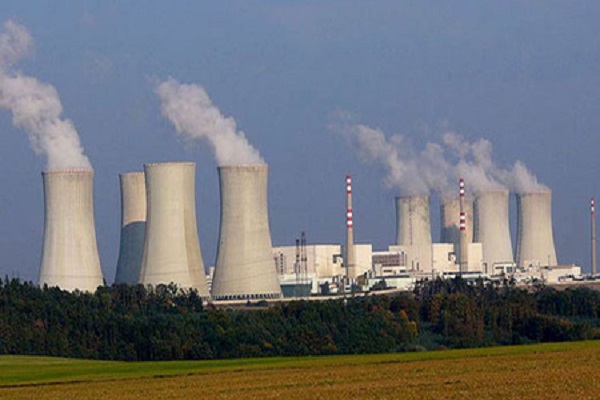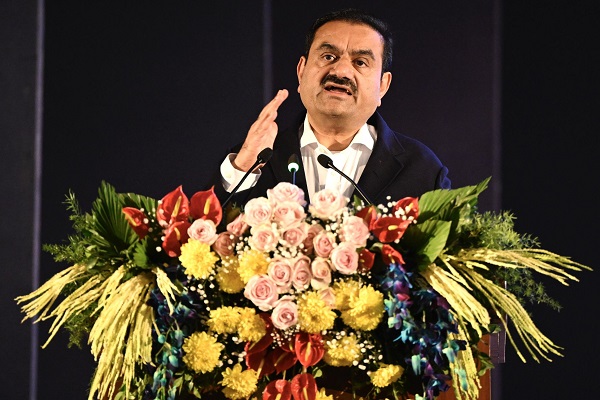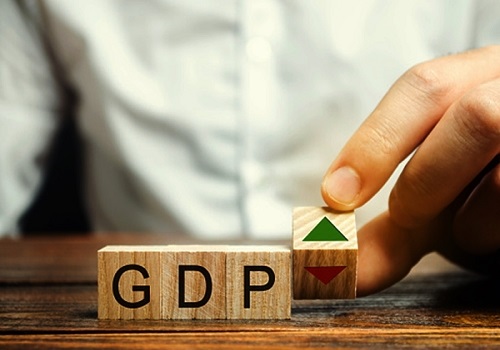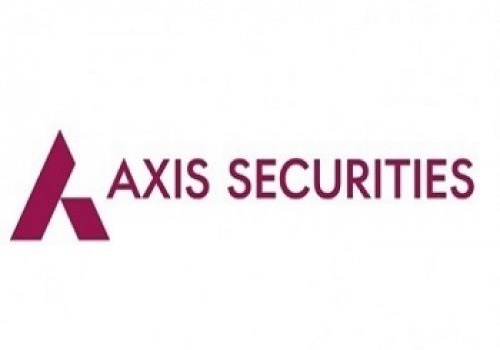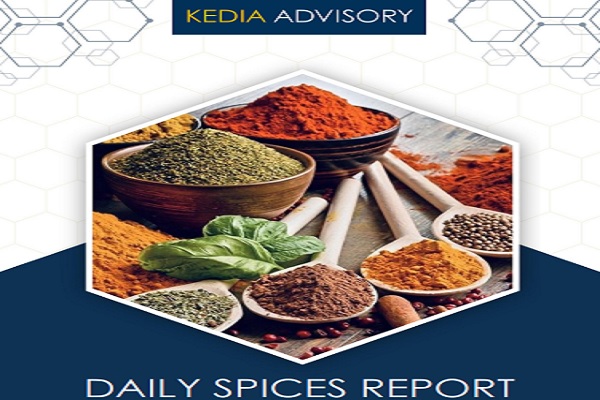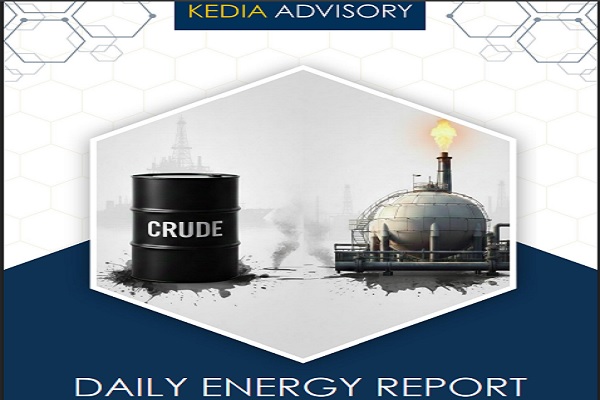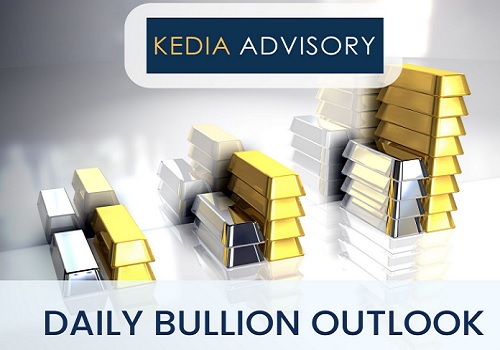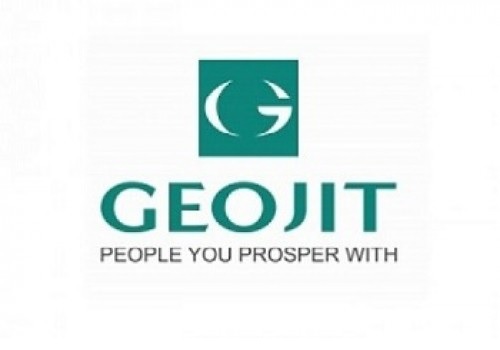Cottoncandy trading range for the day is 53570-54370. - Kedia Advisory

Gold
Gold prices surged by 0.8% to 95,599 amid mounting geopolitical tensions and continued weakness in the US dollar. The rally was supported by concerns that the Middle East conflict could escalate following reports of Israel planning strikes on Iranian nuclear sites, which may trigger a retaliatory response from Iran. Further uncertainty stemmed from comments by former US President Trump suggesting a potential ceasefire in the Russia-Ukraine conflict but with no active US mediation, deepening the global geopolitical unease. The US dollar’s subdued performance, influenced by the Federal Reserve's cautious economic outlook and Moody's downgrade of the US credit rating due to surging debt levels, added to gold's appeal as a safe-haven asset. In the physical markets, lower global prices sparked renewed demand across major Asian hubs. According to the World Gold Council, global gold demand in Q1 2025 rose 1% year-on-year to 1,206 metric tons. This growth was fueled by a 170% surge in investment demand, particularly from gold-backed ETFs and a 14% rise in gold bar demand, which offset a 32% decline in coin purchases. Central bank buying dropped by 21% to 243.7 tons, while global jewellery demand fell sharply by 21% amid elevated prices. Technically, gold remains in a bullish phase with fresh buying activity, evidenced by a 0.21% rise in open interest to 10,524. Immediate support is at 95,185, below which prices may test 94,765. Resistance is seen at 95,865, and a breakout above could drive prices toward 96,125.
Trading Ideas:
* Gold trading range for the day is 94765-96125.
* Gold rose supported by geopolitical risks and persistent weakness in the US dollar.
* Trump announced imminent Russia-Ukraine ceasefire talks but signaled limited U.S. involvement.
* Weak US dollar supported gold, pressured by Fed’s cautious outlook and credit downgrade.
Silver
Silver prices climbed 0.98% to settle at 98,245, supported by a weakened US dollar and robust industrial demand. The dollar pulled back despite rising long-term US Treasury yields, reflecting investor skepticism about US asset outperformance and prompting a renewed flow into precious metals for safety. Heightened geopolitical tensions, notably Israel’s consideration of military action against Iran, further bolstered silver’s appeal as a safe-haven asset. Industrial demand remains a strong tailwind, particularly from the solar energy sector. China’s solar and wind capacity surged to nearly 1,500 GW in Q1 2025, with solar alone growing by 60 GW. Similarly, Europe’s solar power output jumped 30% year-on-year, underscoring silver’s increasing role in green energy technologies. The Silver Institute forecasts another market deficit in 2025—the fifth consecutive year—with a projected shortfall of 117.6 million troy ounces. While overall silver demand is expected to dip by 1%, industrial fabrication is set to hit a record, exceeding 700 million ounces, driven by the green economy and growing physical investment demand. Technically, the market is experiencing short covering, evidenced by a 7.67% drop in open interest to 17,331, alongside a 957 price rise. Silver finds immediate support at 97,435, with deeper support at 96,630. On the upside, resistance is seen at 98,920, and a breakout could lead to a test of 99,600.
Trading Ideas:
* Silver trading range for the day is 96630-99600.
* Silver rose amid a pullback for the dollar and evidence of ample industrial buying.
* Demand for safety was also underpinned by reports that Israel is considering striking Iran, extending geopolitical tensions.
* Industrial silver demand stayed strong, driven by rising solar panel investments.
Crude oil
Crude oil prices declined by 0.73% to settle at 5,295, pressured by bearish U.S. inventory data released ahead of the summer driving season, typically a period of heightened demand. The Energy Information Administration (EIA) reported a surprising 1.3 million barrel increase in crude inventories, contrary to market expectations of a drawdown. Additionally, gasoline stocks rose by 816,000 barrels and distillate inventories climbed by 580,000 barrels, further dampening sentiment. However, the downside was limited by ongoing geopolitical tensions, particularly concerns that Israel may launch an attack on Iranian nuclear facilities, potentially disrupting Middle East oil flows. On the macroeconomic front, the International Energy Agency (IEA) slightly revised its 2025 global oil demand growth forecast upward to 740,000 bpd, citing support from economic resilience and lower oil prices. Nonetheless, the IEA warned of slower demand in the latter half of the year, projecting growth to decelerate to 650,000 bpd due to economic headwinds and rising electric vehicle sales. Technically, the market is under fresh selling pressure, evidenced by a 7.01% rise in open interest to 11,082, indicating new short positions. Crude oil now finds immediate support at 5,225, with further downside risk towards 5,154. On the upside, resistance is expected at 5,402, and a break above could push prices towards 5,508.
Trading Ideas:
* Crudeoil trading range for the day is 5154-5508.
* Crude oil dropped after a surprise build in US crude inventories.
* Geopolitical risks limited losses amid reports of Israel preparing to strike Iran
* Crude inventories rose by 1.3 million barrels to 443.2 million barrels, the EIA said.
Natural gas
Natural gas prices edged down by 0.27% to settle at 290.4, pressured by a smaller-than-anticipated decline in U.S. output and expectations of easing demand. Although output in the Lower 48 U.S. states fell to 104.9 billion cubic feet per day (bcfd) so far in May—down from April's record 105.8 bcfd—Wednesday's preliminary figure of 103.9 bcfd marked only a modest drop compared to previous forecasts. This limited the upward momentum for prices. Demand is forecast to dip, with LSEG projecting Lower 48 gas consumption, including exports, to decline from 99.4 bcfd this week to 94.9 bcfd next week, aligning with expectations of continued warmer-than-normal weather through early June. Meanwhile, U.S. utilities added 110 Bcf to storage for the week ending May 9, in line with market estimates and reflecting ample supply. Stockpiles are 375 Bcf below last year’s levels but still 57 Bcf above the five-year norm. On the outlook front, the U.S. Energy Information Administration (EIA) anticipates record production and consumption in 2025. Technically, the market is under long liquidation, with open interest dropping by 20.86% to 10,731, while prices slipped 0.8. Natural gas is currently finding support at 284.1, with further downside potential to 277.8. Resistance is seen at 298.6, and a breakout above could lift prices towards 306.8.
Trading Ideas:
* Naturalgas trading range for the day is 277.8-306.8.
* Natural gas fell on a smaller than previously expected decline in daily output so far this month.
* Gas stockpiles were already around 3% above the five-year (2020-2024) average.
* Average gas output in the Lower 48 U.S. states fell to 104.9 bcfd so far in May
Copper
Copper prices slipped marginally by 0.09% to settle at 857.45, weighed down by mixed market fundamentals and uncertainty around global demand. A key factor exerting pressure was the ample copper supply in North America, alongside concerns about manufacturing demand amid escalating tariff risks. The recent U.S. tariff probe on copper imports spurred traders to unwind long positions, adding to the bearish sentiment. On the monetary policy front, the People's Bank of China kept the one-year Loan Prime Rate at 3.0% and the five-year rate at 3.5%, signaling a steady approach that did little to boost industrial demand expectations. Meanwhile, copper inventory data offered a mixed picture. LME copper inventories dropped to 179,375 metric tons, a 10.5-month low, hinting at some supply tightness. In contrast, inventories at the Shanghai Futures Exchange surged 34% to 108,142 metric tons, while COMEX inventories in the U.S. climbed to a six-year high of 169,664 metric tons. Global copper trade flows also reflected shifting dynamics. China's copper imports were flat year-on-year in April but fell 3.9% in the January–April period, as traders diverted supplies to the U.S. in anticipation of tariffs. The global refined copper market posted a surplus of 61,000 metric tons in February, down from 90,000 in January. Technically, copper is in a phase of long liquidation, with open interest falling by 5.94% to 2,740. Support lies at 854.2, with deeper downside potential toward 851. Resistance is now seen at 862.5, with a break above likely to test 867.6.
Trading Ideas:
* Copper trading range for the day is 851-867.6.
* Copper dropped amid risks to manufacturing demand and ample supply in America.
* Pressure also seen due to ongoing uncertainties about economic growth stemming from tariffs.
* Strong South American ore output raised surplus fears, prompting traders to unwind US long positions.
Zinc
Zinc prices edged lower by 0.27% to settle at 259.5 amid ongoing concerns over global manufacturing activity and signs of easing supply constraints. Although macroeconomic risk aversion softened due to a temporary pause in Sino-US trade tensions and slightly better-than-expected U.S. April inflation data—which revived hopes for interest rate cuts—the underlying fundamentals still weighed on the market. On the supply side, spot zinc availability remains tight due to increased smelter maintenance, and historically low inventory levels offered some support to prices. However, the rise in treatment charges (TCs) for zinc concentrate and the ramp-up of new smelting capacities globally suggest that supply is likely to outpace demand in the coming months. The International Lead and Zinc Study Group (ILZSG) projected a surplus in the global refined zinc market in 2025, with output expected to rise 1.8% to 13.73 million tons, outpacing a 1% increase in demand to 13.64 million tons. In China, refined zinc production in April rose 1.6% month-on-month and approximately 10% year-on-year, though cumulative output growth from January to April stood at a modest 0.3% YoY. May production is forecast to rise marginally month-on-month and over 3% year-on-year. Technically, the zinc market is in a phase of long liquidation, with open interest declining by 8.04% to 1,566. Immediate support lies at 258.3, with deeper downside potential toward 257.1. Resistance is seen at 261.3, and a breakout above could lead to a test of 263.1.
Trading Ideas:
* Zinc trading range for the day is 257.1-263.1.
* Zinc fell on global manufacturing concerns and signs of easing supply constraints.
* Temporary US-China trade calm and soft US inflation data revived rate cut hopes.
* Zinc smelter maintenance tightened spot supply, but not enough to sustain price support.
Aluminium
Aluminium prices declined by 0.5% to settle at 238.4, pressured by rising inventories and a subdued macroeconomic backdrop. A significant surge in LME aluminium inventories, which jumped by nearly 93,000 tonnes to 343,025 tonnes on May 18—the largest daily rise in over a year—reflected increased re-warranting activity by traders seeking to avoid losses from rolling over short positions amid ongoing backwardation in futures markets. Although the inventory later eased slightly, the spike signaled ample market availability. In China, aluminium production continues to rise, driven by favorable hydropower conditions in Yunnan, allowing smelters to capitalize on lower costs. April's output increased by 4.2% year-on-year to 3.75 million metric tons, and cumulative output for January to April stood at 14.79 million metric tons, marking a 3.4% increase. Despite this, a sharp price correction was avoided due to expectations of output slowing later in the year as smelters approach Beijing’s cap of 45 million tonnes. Meanwhile, China's macroeconomic indicators presented a mixed picture, with factory output and retail sales missing expectations and real estate market stagnation persisting—factors that weigh on aluminium demand sentiment. Technically, the aluminium market is under long liquidation, evidenced by a 13.32% drop in open interest to 1,790. Immediate support is at 237.1, with further downside potential to 235.6. Resistance is likely at 240.4, and a breakout above this level could push prices toward 242.2.
Trading Ideas:
* Aluminium trading range for the day is 235.6-242.2.
* Aluminium dropped amid increased inventories and an uncertain macroeconomic backdrop.
* Open tonnage of aluminium in LME inventories surged by nearly 93,000 tonnes overnight to 343,025 tons.
* Global primary aluminium output in April rose 2.2% year on year to 6.033 million tonnes – IAI
Cottoncandy
Cottoncandy prices declined by 0.54% to settle at 53,910 amid profit booking after recent gains driven by supply-side concerns. The Cotton Association of India (CAI) revised its domestic crop estimate lower by 4 lakh bales to 291.30 lakh bales for the 2024–25 season, mainly due to reduced output in Maharashtra. This downgrade from the earlier projection of 295.30 lakh bales reflects reports from state member associations as of March end. Despite the downward revision in domestic output, overall cotton supply till March—including imports—stood at 306.83 lakh bales. Imports have been significant, with 25 lakh bales arriving at ports and full-season imports now expected to surge to 33 lakh bales, more than doubling last year’s 15.20 lakh bales, driven by tighter domestic availability. Consumption, however, remains flat, and closing stock projections for September 2025 are lower at 23.49 lakh bales, down from last year’s 30.19 lakh bales. Globally, the U.S. cotton balance sheet for 2024–25 shows minor changes, with exports down by 100,000 bales and ending stocks up by the same amount to 5.0 million bales. World cotton production has dipped slightly due to lower output in several countries, though an increase in China partly offsets this. Technically, the market is undergoing long liquidation, with open interest falling by 16.85% to 148. Cottoncandy now finds support at 53,740, with further downside risk to 53,570. Resistance is seen at 54,140, and a break above could lead prices toward 54,370.
Trading Ideas:
* Cottoncandy trading range for the day is 53570-54370.
* Cotton dropped on profit booking after prices gained as CAI expects a shrinkage in crop.
* Cotton exports for the 2024-25 season are pegged at 16 lakh bales, lower by 12.36 lakh bales over previous year’s 28.36 lakh bales.
* The closing stock for 2024-25 season at end of September 2025 is estimated lower at 23.49 lakh bales from same period last year’s 30.19 lakh bales. I
* In Rajkot, a major spot market, the price ended at 26011.95 Rupees dropped by -0.07 percent.
Turmeric
Turmeric prices declined by 1.69% to 14,398 amid a sharp rise in arrivals and sluggish export demand. Total arrivals nearly doubled to 57,500 quintals from 29,860 quintals in the previous session, exerting downward pressure on prices. Despite the recent correction, the downside appears limited due to ongoing concerns over lower yield projections and slow arrivals in key regions. This season, the area under turmeric cultivation increased by 10% to 3.30 lakh hectares compared to last year. However, productivity is expected to fall due to untimely rains and reports of small rhizomes and crop rots, particularly in the Nanded region, which may reduce output by 10-15% from last year’s production of 10.75 lakh tonnes. In the Duggirala market, strong demand for the fresh crop continues, with newer stock commanding a price premium over older inventory due to its superior quality. Despite the season nearing its end, market activity remains robust with daily trading volumes of 1,000 to 1,200 bags. The Himachal Pradesh government has initiated turmeric procurement from May 15 to June 15, encouraging natural farming practices. On the export front, turmeric exports between April and February 2025 rose by 11.51% to 161,229.56 tonnes compared to the same period last year. Technically, the market is witnessing long liquidation, with a 0.75% drop in open interest to 15,865. Turmeric has immediate support at 14,250, below which it may test 14,100. Resistance is seen at 14,600, and a breakout could push prices towards 14,800.
Trading Ideas:
* Turmeric trading range for the day is 14100-14800.
* Turmeric dropped due to increased arrivals and owing to weak export enquiries.
* However downside seen limited amid persistent concerns about lower production estimates.
* Yields expected 10–15% lower; Nanded region hit by crop rot and small rhizomes
* In Nizamabad, a major spot market, the price ended at 14553.3 Rupees dropped by -0.71 percent.
Jeera
Jeera prices fell sharply by 2.07% to 20,820 amid subdued domestic buying and weak export demand, as the retail season draws to a close. The decline was further accelerated by a rise in arrivals, which increased to 32,900 bags from 28,000 bags in the previous session, adding supply-side pressure. Market participants note that the lack of foreign buyer activity and sufficient existing stocks have capped demand, contributing to the bearish sentiment. Farmers still hold an estimated 20 lakh bags of cumin, with only 3–4 lakh bags expected to be traded by the season’s end. This implies a large carry-forward stock of around 16 lakh bags, which may further weigh on prices in the near term. However, export data offers some optimism—jeera exports during April–February 2025 surged by 62.55% to 195,164.58 tonnes compared to the same period in the previous year. Notably, February exports stood at 12,996.88 tonnes, up 18.52% from February 2024, though down 23.92% from January 2025. At the Unjha spot market, prices also declined by 0.85% to 21,440.60. Technically, the market is under long liquidation, with open interest down by 2.62% to 6,576. Jeera has immediate support at 20,620, with further downside potential to 20,410. Resistance is seen at 21,190, and a break above this could push prices toward 21,550.
Trading Ideas:
* Jeera trading range for the day is 20410-21550.
* Jeera dropped due to lower buying and weak export demand.
* The current season is expected to have similar production levels as last year due to better crop conditions.
* In Feb 2025 around 12,996.88 tonnes of jeera were exported as against 17,083.31 tonnes in Jan 2025 showing a drop of 23.92%.
* In Unjha, a major spot market, the price ended at 21440.6 Rupees dropped by -0.85 percent.
Views express by all participants are for information & academic purpose only. Kindly read disclaimer before referring below views
